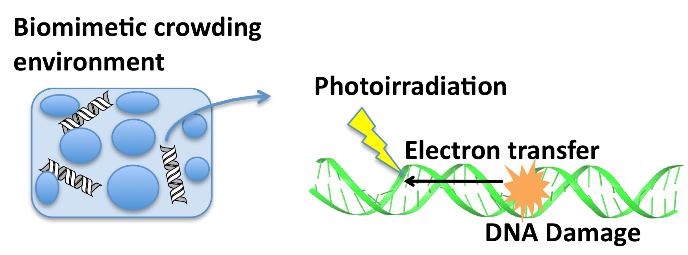March 2018 Issue
Research Highlights
Electron transfer and oxidative damage in DNA under biomimetic crowding environment
It is known that an electron-hole injected into DNA moves through double helical DNA and induces oxidative damage at guanine sites. To-date, this process has only been investigated in aqueous dilute solutions.
However, to clarify the unique characteristics of DNA in vivo, experiments must be performed under conditions close to biological environments because the intracellular environment is highly crowded with 20-40 wt % various biomolecules.
Now, Makiko Tanaka at Department of Engineering Science and colleagues have investigated the effect of the biomimetic medium on DNA damage via photoinduced electron transfer and found that molecular crowding mediums affected the electron transfer and the efficiency of DNA damage.
Upon photoirradiation of pyrene moiety in pyrene-modified DNA, guanine sites in DNA were oxidized via electron transfer and decomposed. The researchers used ethylene glycol, glycerol and poly(ethylene glycol) to produce crowding environments around DNA. The efficiencies of the oxidative damage were analyzed by high-performance liquid chromatography.
A high viscosity of the crowding environment reduced damage in DNA. When the DNA contained a mismatched base pair, a local structural change of DNA and a low dielectric constant of these crowding mediums promoted DNA damage via through-space electron transfer.
These results suggest that the electron transfer and the oxidative damage in DNA under intracellular environments have wide variety according to the situation.




